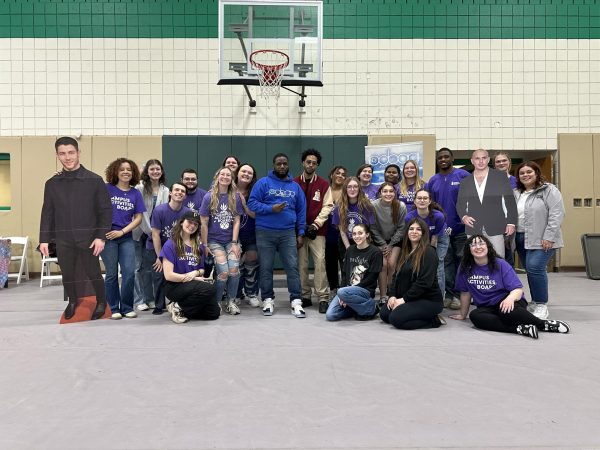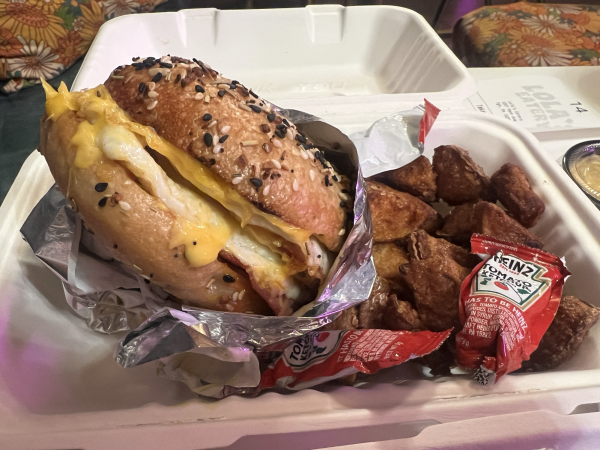March unites Pittsburgers, ‘Burghers for Bernie’

photo by Shayna Mendez
Amanda Horn, sophomore economics & finance major and Maia Gilmour, sophomore psychology major jam out to music played at the rally before the start of the speeches supporting Bernie Sanders in Market Square on Feb. 27.
In preparation for Pennsylvania’s April primary, over 1,000 activists marched from the University of Pittsburgh to downtown Pittsburgh on Saturday, Feb. 27 in support of Democratic presidential candidate Bernie Sanders.
The crowd trekked three miles, beginning at the Cathedral of Learning on the University of Pittsburgh’s campus and continued down Fifth Avenue to Market Square.
Greg Schaffer, one of the event’s organizers and a member of the Pittsburgh pro-Sanders advocacy group, “Burghers for Bernie,” said one of the main goals of the march was to raise awareness for Sanders as a viable candidate to voters in the region.
“Part of the hurdle is psychological, that we can elect this person,” said Schaffer in a phone interview. “One of the important parts of having a huge public manifestation of public support is a resistance to this idea. It’s showing people that there is support for him in the region.”
The march itself enjoyed plenty of support. By “Burghers for Bernie’s” own count, the crowd topped off at approximately 1,200 people, analyzed by a video taken at the corner of Fifth Ave and Washington Place in front of CONSOL Energy Center, which was set to host a Pittsburgh Penguins game three hours later. The Pittsburgh Post-Gazette reported a more conservative number of 750 marchers.
Derek Morris, an organizer for the march, created the event through Facebook, which quickly blossomed to show more than 1,000 people with the intention of attending.
“I was expecting 200 if I was lucky,” Morris said before the march. “Without ‘Burghers for Bernie,’ I don’t think I could do it myself. This was a team effort.”
Canopies with tables set up for voter registration and volunteer sign-ups were set up in front of the Cathedral of Learning and Market Square during the subsequent rally. Schaffer said that 362 people signed up to volunteer with “Burghers for Bernie” and over 100 registered to vote at the rally.
“Hillary [Clinton] won Pennsylvania in ’08, and she has a pretty sophisticated support system here, including politicians,” Schaffer said before the march began. “To keep her from coming through and having an easy picking of things, we have to build a sense of community voters.”
Sanders faces an uphill climb in securing delegates for nomination at the Democratic National Convention, held in Philadelphia this year. After the Super Tuesday primaries, Sanders holds 407 delegates to Clinton’s 596. Clinton has a clear advantage over Sanders with the Democratic Party’s superdelegates — unelected party officials who are free to support any candidate they choose at the Democratic National Convention. Clinton has 457 superdelegates counted in support while Sanders has a mere 22, though they are within their rights to switch their support.
Pennsylvania will serve as an especially tough test for Sanders’ campaign, as most of the state’s politicians have already endorsed Clinton.
“Hillary has the support of the establishment,” Schaffer said. “She doesn’t have to visit PA once and she’ll be in a good position,” Schaffer said.
Braddock, Pa. Mayor John Fetterman was the headlining speaker at the rally in Market Square. Fetterman is seeking the Democratic nomination to run for the U.S. Senate seat currently held by Pat Toomey. Fetterman boasted that he is the only U.S. Senate candidate to openly endorse Bernie Sanders for candidate.
“It’s risky to endorse Sanders from a political perspective. There’s something to admire in the courage to endorse someone you believe in,” said Schaffer of Fetterman.
Fetterman spoke briefly with his children on stage and raised several political issues that garnered applause from the crowd. Fetterman spoke of repealing Citizens United, ending the war on drugs and reforming the law of marijuana classification and enforcement, and tackling social inequality.
“If you think inequality is just one issue, you don’t get it,” Fetterman said during his speech. “Inequality is every issue and how it permeates society.”
Other speakers at the event included Iraq War veteran Helen Gerhardt, Deputy Director for Pittsburgh NORML Theresa Nightingale, KDKA radio personality Chris Moore, student and immigrant rights activist Marcela Anita and Mike Gallagher, the Eastern Region Coordinator for the American Postal Workers Union.
Point Park University photojournalism senior Ren Finkel was particularly impressed by Anita at the rally.
“It is important that we keep a global outlook,” Finkel said at the march in Market Square. “I liked her quote at the end, ‘The only thing we have left to lose are our chains.’ I think that summed everything up well.”
A common enemy both during the march and rally throughout the day was Republican frontrunner Donald Trump. A chalk drawing made on Bigelow Boulevard when the crowd gathered before the march began read, “Mr. Trump, are you listening yet?” Gallagher mocked Trump’s “Make America Great Again” campaign slogan during his speech, instead offering that Sanders would be the best candidate to do so.
Fetterman opened his speech by calling Trump a “jagoff,” which was met laughter and cheers, especially after the American sign language interpreter repeated the line.
Many other political and social movements found support during the march and subsequent rally. Frequent chants of “Black Lives Matter” sprang from the crowd as it moved down Fifth Avenue. Morris made criminal justice and marijuana legalization reform key points during his speech at the onset of the march.
Clinton was an absent topic during much of the march and rally, only mentioned in innuendo by the speakers.
“There could’ve been a negative energy of Hillary bashing or anti-establishment. We wanted to put a positive impression to the city and region. I think we really pulled that off well,” Schaffer said.
The crowd at the march showcased a surprising diversity in ages. Sanders has dominated the millennial vote, with exit polls showing he won their vote in every state on Super Tuesday. However, Sanders has struggled to collect numbers among voters over 40 years old.
At the march, however, a large number of older voters showed up to join the crowd.
“It was really a diverse spectrum of people, which says a lot considering it was a three mile walk,” Schaffer said. “There were senior citizens making that walk.”

photo by Liz Berie
Marchers Anne and Bill McCormick pose with their Bernie signs at the rally after the march. Supporters of Bernie Sanders rallied in The March For Bernie Sanders on Feb. 27 by the Cathedral of Learning in Oakland. The march began on Fifth Avenue and stretched down to Market Square.
Exit polls have shown that Sanders continues to struggle drawing black voters, particularly in the South, to vote for him. In Texas, Sanders only won 33 percent of the Hispanic voting block, compared to 67 percent by Clinton.
The Sanders march reflected these numbers, as a mostly white crowd marched down Fifth Avenue, though Morris pointed to the speakers at the rally as evidence of diverse support for the junior senator from Vermont.
“I think our speakers gave a good representation of the different racial backgrounds that support Senator Sanders,” Morris said. “The demographics we saw at the march might surprise some people. There were people of all backgrounds from all walks of life.”
Marchers at the event believed Sander’s campaign success will come down to grassroots activism and young voters showing up to the polls. One sign at the march read “Fight Apathy – Get Involved”.
“This is the most important election in decades,” said senior cinema major Dane Hager before the march began. “I believe that youth turnout will be important in deciding it.
“A lot of people involved are younger people, and I think that we, in particular, are more involved in volunteering and getting the message out there to our friends,” Morris agreed.
Finkel believed that the march was a step forward in getting younger voters into polling stations.
“We need to get young people more actively involved. It’s great to get involved to get other people involved, whether it is in the democratic voting process or otherwise,” Finkel said. “It was awesome to see so many people passionate and invested today. I didn’t expect this turnout.”

photo by Liz Berie

photo by Liz Berie





